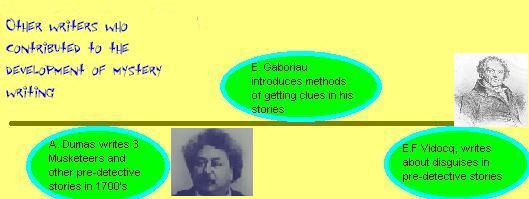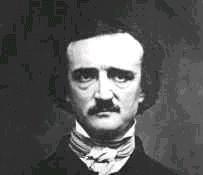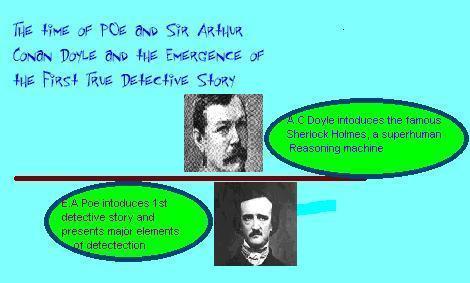 Sir Arthur Conan Doyle is one the greatest mystery writers in existence, but he is part of a long line of writers from the beginnings in early 1700's to the present 21st century. There has been a long evolution of mystery writing in this time span, which has witnessed changes in the types of characters, the plot and the overall theme, as different writers came into this field.
Sir Arthur Conan Doyle is one the greatest mystery writers in existence, but he is part of a long line of writers from the beginnings in early 1700's to the present 21st century. There has been a long evolution of mystery writing in this time span, which has witnessed changes in the types of characters, the plot and the overall theme, as different writers came into this field.
 Edgar Allen Poe is most often credited for writing the first detective fiction stories, but past authors wrote stories that resembled detective fiction. Pre-Poe authors include Alexandre Dumas (works include the Three Musketeers) and there was evidence of deduction through analysis of the situation and clues. French author Francois Eugene Vidocq was important towards starting the development of detective fiction, and his writing contributed to Conan Doyle's use of disguise in his Sherlock Holmes novels.
Edgar Allen Poe is most often credited for writing the first detective fiction stories, but past authors wrote stories that resembled detective fiction. Pre-Poe authors include Alexandre Dumas (works include the Three Musketeers) and there was evidence of deduction through analysis of the situation and clues. French author Francois Eugene Vidocq was important towards starting the development of detective fiction, and his writing contributed to Conan Doyle's use of disguise in his Sherlock Holmes novels.
 Poe wrote 5 short stories, which included the ideas of the past authors, and the principles used by detective story authors in the 20th century, including Conan Doyle. The main ideas Poe presented are, situations where crimes occur in the most impossible location ("locked-room cases"), solutions derived from coded-messages, situations where the most unlikely person is the murderer, and the theory where the most improbable possibility is correct after all other possibilities are rejected. The solutions in his tails are based on reasoning and they introduce the detective as a "reasoning machine" rather than as a human being. Emile Gaboriau, another detective mystery writer (after Poe's time), was an influence toward Conan Doyle. In some of his works, he gave a description of how to make plaster casts of footprints and to show a clock watch may be set up to give clues.
Despite being influenced by past writers of detective fiction, Conan Doyle was able to transform everything he borrowed and contribute to the further development of detective fiction. Sherlock Holmes is regarded as the greatest fictional detective of all time, and Conan Doyle has performed a magnificent job in displaying Holmes as a superhuman reasoning machine. He led to the use of the "great detective" by future authors, and characteristics of such figures include arrogance, highly intelligent and self-absorbed. Conan Doyle used the criminal identification systems that relied on physical aspects of criminals, because a fingerprinting system was not invented yet. Holmes's ability to read Watson's mind in some instances where taken from Poe, and this is portrayed in the story of The Adventure of the Cardboard Box. In this story, Conan Doyle also noted Holmes' observation ablities such as being able to correlate relations between people by matching ear shapes, or the origin of a package from the type of box and string used to deliver the contents. The scientific and logical portrayal of Sherlock Holmes impressed Victorian audiences. Conan Doyle gave Sherlock Holmes the knowledge of various crime detection skills and other extraordinary knowledge, which was derived from past and present influences. Conan Doyle used keen observation tactics that he learned from his professor, Dr. Joseph Bell, in his short stories, so writers were not the only influence.
Later authors brought on different techniques, which led to the end of the superhuman reasoning expert as the detective, but a character with more human traits, and novels surpassed short story as the dominant form. However, despite current interest in spy-thrillers and crime novels, Sherlock Holmes is still read today and is still one of the greatest fictional detectives.
Poe wrote 5 short stories, which included the ideas of the past authors, and the principles used by detective story authors in the 20th century, including Conan Doyle. The main ideas Poe presented are, situations where crimes occur in the most impossible location ("locked-room cases"), solutions derived from coded-messages, situations where the most unlikely person is the murderer, and the theory where the most improbable possibility is correct after all other possibilities are rejected. The solutions in his tails are based on reasoning and they introduce the detective as a "reasoning machine" rather than as a human being. Emile Gaboriau, another detective mystery writer (after Poe's time), was an influence toward Conan Doyle. In some of his works, he gave a description of how to make plaster casts of footprints and to show a clock watch may be set up to give clues.
Despite being influenced by past writers of detective fiction, Conan Doyle was able to transform everything he borrowed and contribute to the further development of detective fiction. Sherlock Holmes is regarded as the greatest fictional detective of all time, and Conan Doyle has performed a magnificent job in displaying Holmes as a superhuman reasoning machine. He led to the use of the "great detective" by future authors, and characteristics of such figures include arrogance, highly intelligent and self-absorbed. Conan Doyle used the criminal identification systems that relied on physical aspects of criminals, because a fingerprinting system was not invented yet. Holmes's ability to read Watson's mind in some instances where taken from Poe, and this is portrayed in the story of The Adventure of the Cardboard Box. In this story, Conan Doyle also noted Holmes' observation ablities such as being able to correlate relations between people by matching ear shapes, or the origin of a package from the type of box and string used to deliver the contents. The scientific and logical portrayal of Sherlock Holmes impressed Victorian audiences. Conan Doyle gave Sherlock Holmes the knowledge of various crime detection skills and other extraordinary knowledge, which was derived from past and present influences. Conan Doyle used keen observation tactics that he learned from his professor, Dr. Joseph Bell, in his short stories, so writers were not the only influence.
Later authors brought on different techniques, which led to the end of the superhuman reasoning expert as the detective, but a character with more human traits, and novels surpassed short story as the dominant form. However, despite current interest in spy-thrillers and crime novels, Sherlock Holmes is still read today and is still one of the greatest fictional detectives.
 |
 Sir Arthur Conan Doyle is one the greatest mystery writers in existence, but he is part of a long line of writers from the beginnings in early 1700's to the present 21st century. There has been a long evolution of mystery writing in this time span, which has witnessed changes in the types of characters, the plot and the overall theme, as different writers came into this field.
Sir Arthur Conan Doyle is one the greatest mystery writers in existence, but he is part of a long line of writers from the beginnings in early 1700's to the present 21st century. There has been a long evolution of mystery writing in this time span, which has witnessed changes in the types of characters, the plot and the overall theme, as different writers came into this field.
 Edgar Allen Poe is most often credited for writing the first detective fiction stories, but past authors wrote stories that resembled detective fiction. Pre-Poe authors include Alexandre Dumas (works include the Three Musketeers) and there was evidence of deduction through analysis of the situation and clues. French author Francois Eugene Vidocq was important towards starting the development of detective fiction, and his writing contributed to Conan Doyle's use of disguise in his Sherlock Holmes novels.
Edgar Allen Poe is most often credited for writing the first detective fiction stories, but past authors wrote stories that resembled detective fiction. Pre-Poe authors include Alexandre Dumas (works include the Three Musketeers) and there was evidence of deduction through analysis of the situation and clues. French author Francois Eugene Vidocq was important towards starting the development of detective fiction, and his writing contributed to Conan Doyle's use of disguise in his Sherlock Holmes novels.
 Poe wrote 5 short stories, which included the ideas of the past authors, and the principles used by detective story authors in the 20th century, including Conan Doyle. The main ideas Poe presented are, situations where crimes occur in the most impossible location ("locked-room cases"), solutions derived from coded-messages, situations where the most unlikely person is the murderer, and the theory where the most improbable possibility is correct after all other possibilities are rejected. The solutions in his tails are based on reasoning and they introduce the detective as a "reasoning machine" rather than as a human being. Emile Gaboriau, another detective mystery writer (after Poe's time), was an influence toward Conan Doyle. In some of his works, he gave a description of how to make plaster casts of footprints and to show a clock watch may be set up to give clues.
Despite being influenced by past writers of detective fiction, Conan Doyle was able to transform everything he borrowed and contribute to the further development of detective fiction. Sherlock Holmes is regarded as the greatest fictional detective of all time, and Conan Doyle has performed a magnificent job in displaying Holmes as a superhuman reasoning machine. He led to the use of the "great detective" by future authors, and characteristics of such figures include arrogance, highly intelligent and self-absorbed. Conan Doyle used the criminal identification systems that relied on physical aspects of criminals, because a fingerprinting system was not invented yet. Holmes's ability to read Watson's mind in some instances where taken from Poe, and this is portrayed in the story of The Adventure of the Cardboard Box. In this story, Conan Doyle also noted Holmes' observation ablities such as being able to correlate relations between people by matching ear shapes, or the origin of a package from the type of box and string used to deliver the contents. The scientific and logical portrayal of Sherlock Holmes impressed Victorian audiences. Conan Doyle gave Sherlock Holmes the knowledge of various crime detection skills and other extraordinary knowledge, which was derived from past and present influences. Conan Doyle used keen observation tactics that he learned from his professor, Dr. Joseph Bell, in his short stories, so writers were not the only influence.
Later authors brought on different techniques, which led to the end of the superhuman reasoning expert as the detective, but a character with more human traits, and novels surpassed short story as the dominant form. However, despite current interest in spy-thrillers and crime novels, Sherlock Holmes is still read today and is still one of the greatest fictional detectives.
Poe wrote 5 short stories, which included the ideas of the past authors, and the principles used by detective story authors in the 20th century, including Conan Doyle. The main ideas Poe presented are, situations where crimes occur in the most impossible location ("locked-room cases"), solutions derived from coded-messages, situations where the most unlikely person is the murderer, and the theory where the most improbable possibility is correct after all other possibilities are rejected. The solutions in his tails are based on reasoning and they introduce the detective as a "reasoning machine" rather than as a human being. Emile Gaboriau, another detective mystery writer (after Poe's time), was an influence toward Conan Doyle. In some of his works, he gave a description of how to make plaster casts of footprints and to show a clock watch may be set up to give clues.
Despite being influenced by past writers of detective fiction, Conan Doyle was able to transform everything he borrowed and contribute to the further development of detective fiction. Sherlock Holmes is regarded as the greatest fictional detective of all time, and Conan Doyle has performed a magnificent job in displaying Holmes as a superhuman reasoning machine. He led to the use of the "great detective" by future authors, and characteristics of such figures include arrogance, highly intelligent and self-absorbed. Conan Doyle used the criminal identification systems that relied on physical aspects of criminals, because a fingerprinting system was not invented yet. Holmes's ability to read Watson's mind in some instances where taken from Poe, and this is portrayed in the story of The Adventure of the Cardboard Box. In this story, Conan Doyle also noted Holmes' observation ablities such as being able to correlate relations between people by matching ear shapes, or the origin of a package from the type of box and string used to deliver the contents. The scientific and logical portrayal of Sherlock Holmes impressed Victorian audiences. Conan Doyle gave Sherlock Holmes the knowledge of various crime detection skills and other extraordinary knowledge, which was derived from past and present influences. Conan Doyle used keen observation tactics that he learned from his professor, Dr. Joseph Bell, in his short stories, so writers were not the only influence.
Later authors brought on different techniques, which led to the end of the superhuman reasoning expert as the detective, but a character with more human traits, and novels surpassed short story as the dominant form. However, despite current interest in spy-thrillers and crime novels, Sherlock Holmes is still read today and is still one of the greatest fictional detectives.
